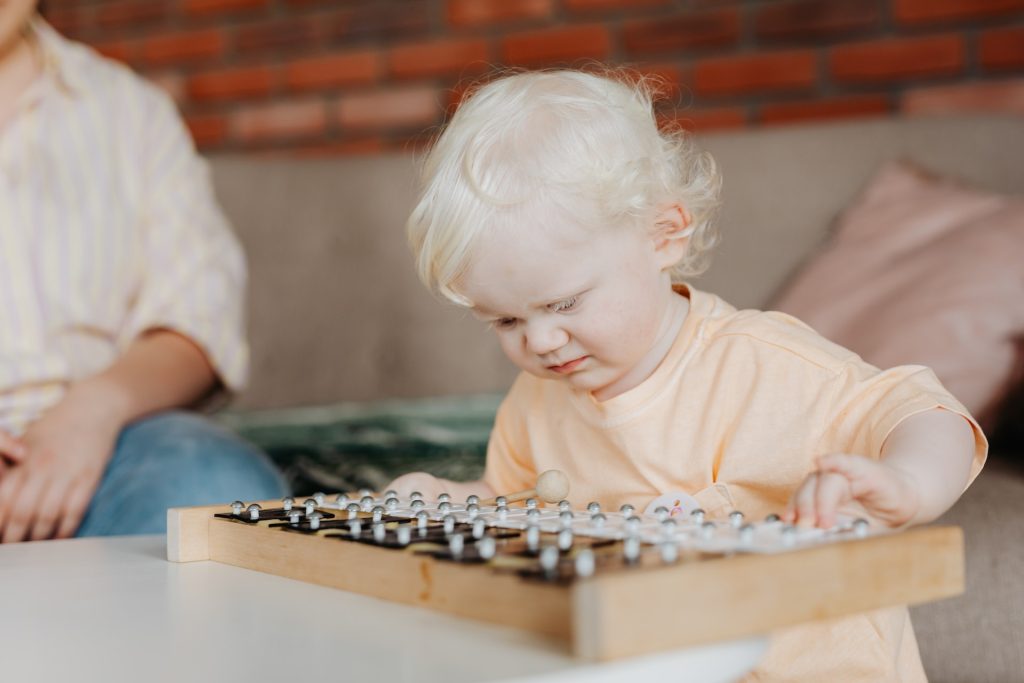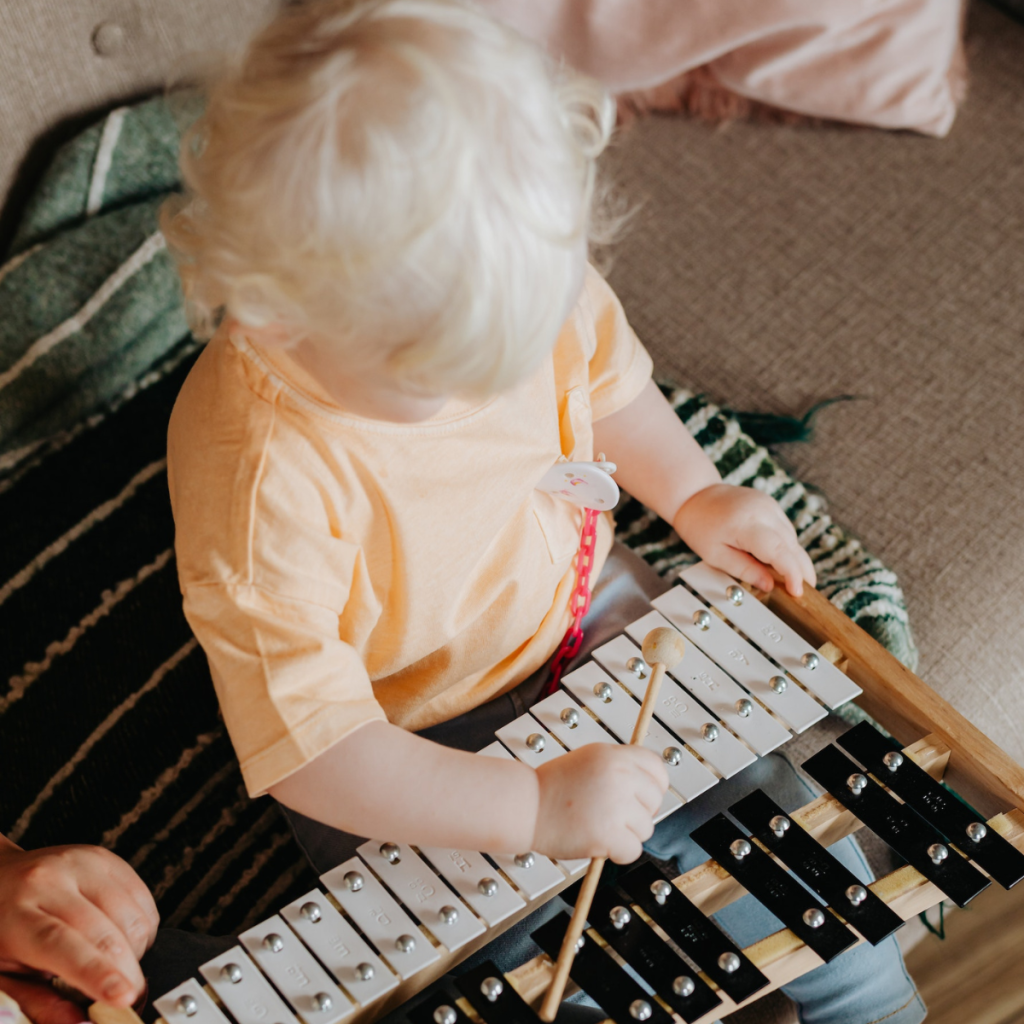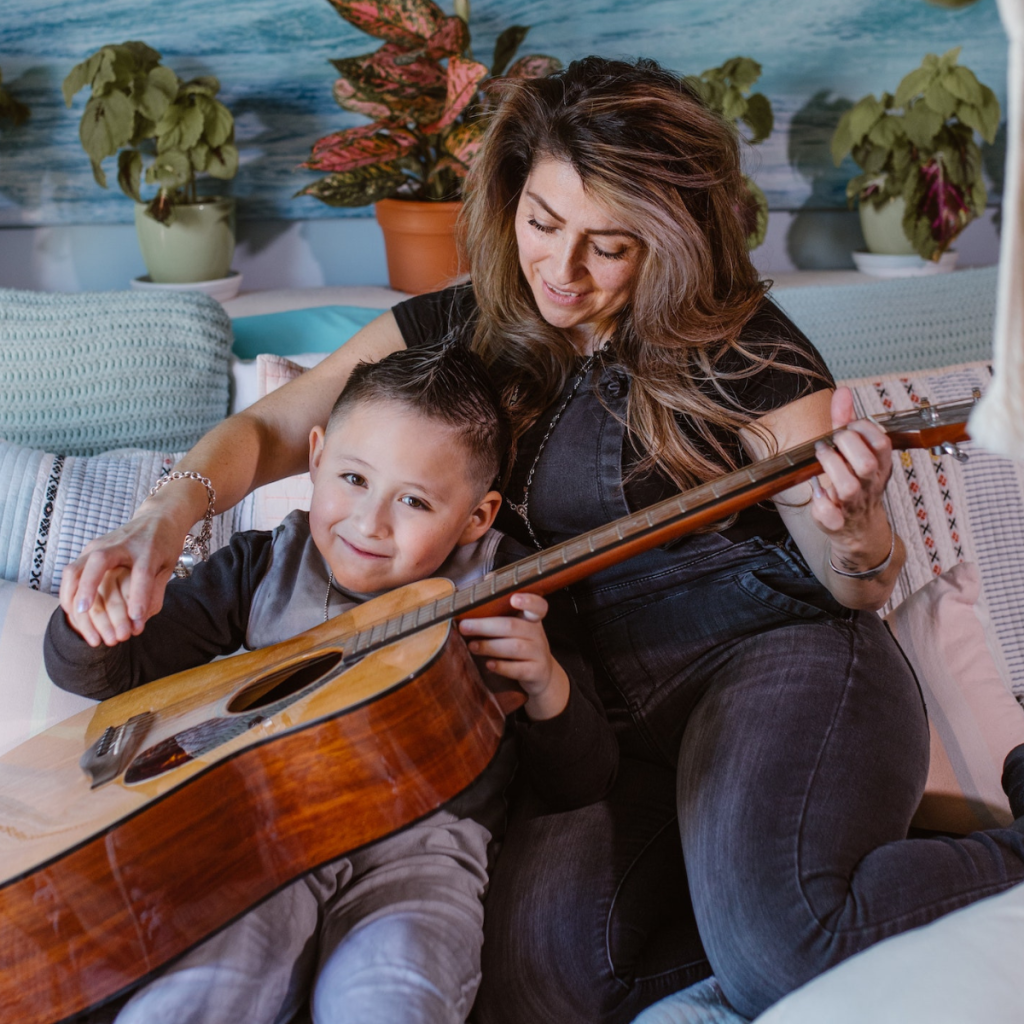Discover effective tips and strategies for teaching an instrument to a 2-3 year old child.
Teaching an Instrument to a 2-3 Year Old Child: Tips and Strategies
Teaching an instrument to a 2-3 year old child can be a challenging yet rewarding experience. At this age, children are like little sponges, absorbing everything around them and eager to explore new things. As a parent or teacher, it’s important to understand their learning capabilities, choose the right instrument, create a conducive learning environment, employ effective teaching techniques, and deal with challenges and setbacks along the way.
Understanding the Learning Capabilities of a 2-3 Year Old

Before diving into teaching an instrument, it’s crucial to understand the cognitive development and physical abilities of children in this age range.
When it comes to the cognitive development of children between the ages of 2-3, it’s important to note that they are going through a rapid period of growth. Their brains are like sponges, soaking up information and making connections at an astonishing rate. During this stage, they are beginning to understand cause and effect, follow simple instructions, and engage in pretend play. It’s fascinating to witness their curiosity and eagerness to learn about the world around them.
However, it’s essential to keep in mind that their attention span may still be relatively short. This means that when teaching them an instrument, it’s best to keep the lessons short and engaging. By doing so, you can capture their interest and maintain their focus throughout the learning process. Incorporating interactive and hands-on activities into the lessons can also help to keep them actively engaged.
Cognitive Development at this Age
Children between the ages of 2-3 are developing their cognitive abilities rapidly. They are beginning to understand cause and effect, follow simple instructions, and engage in pretend play. However, their attention span may still be short, so keep lessons short and engaging.
During this stage, their brains are like sponges, eagerly soaking up information and making connections. They are curious about the world around them and are constantly exploring and learning. It’s a magical time of discovery and growth.
As they begin to understand cause and effect, they may enjoy experimenting with different sounds and rhythms. This is a great opportunity to introduce them to the world of music and instruments. By providing them with age-appropriate instruments and guidance, you can foster their love for music and encourage their cognitive development.
Physical Abilities and Limitations
At this age, fine motor skills are still developing, so it’s important to choose an instrument that is appropriate for their capabilities. Instruments that involve tapping or clapping, like drums or xylophones, are great choices as they allow children to explore rhythm and sound without too much dexterity.
When it comes to physical abilities, children between the ages of 2-3 are still refining their fine motor skills. This means that their ability to manipulate small objects or perform intricate movements may be limited. Therefore, it’s crucial to choose an instrument that aligns with their current capabilities.
Instruments that involve tapping or clapping, such as drums or xylophones, are excellent options for this age group. These instruments allow children to explore rhythm and sound without requiring too much dexterity. They can experiment with different beats and tones, developing their sense of rhythm and coordination in the process.
By selecting instruments that are suitable for their physical abilities, you can ensure that they have a positive and enjoyable experience while learning. It’s important to create an environment that fosters their natural curiosity and encourages them to explore the world of music.
Choosing the Right Instrument
Choosing the right instrument for a 2-3 year old is crucial as it can determine their level of interest and engagement. It is important to consider various factors when selecting an instrument that will captivate their young minds and foster their love for music.
Factors to Consider
When choosing an instrument, it is essential to consider the child’s interests, preferences, and physical abilities. Each child has their own unique personality and inclinations, so it is important to select an instrument that resonates with them. For example, if your child is drawn to the rhythmic beats of drums, percussion instruments may be an excellent choice. On the other hand, if they are fascinated by the melodic sounds of guitars, a mini guitar or keyboard might be more suitable.
Another factor to consider is the child’s attention span and ability to concentrate on an activity for an extended period. Some instruments require more focus and concentration, while others allow for more playful exploration. It is important to strike a balance between challenging the child and keeping the experience enjoyable.
Additionally, consider the durability and safety of the instrument. Young children are known for their curiosity and exploration, so it is crucial to choose instruments that can withstand their enthusiastic exploration. Look for instruments made from sturdy materials that can withstand the occasional drop or rough handling.
Recommended Instruments for Toddlers
For 2-3 year olds, percussion instruments like drums, shakers, and tambourines are excellent choices as they allow children to explore rhythm, sound, and movement. The rhythmic beats of drums can captivate their attention and provide an outlet for their energy. Shakers and tambourines, with their vibrant sounds and easy playability, can introduce young children to the joy of creating music.
Interactive toys with built-in sounds, such as mini keyboards or guitars, can also spark their interest in music. These toys often come with colorful buttons and keys that produce different sounds, making them engaging and interactive for toddlers. They can experiment with different notes and melodies, fostering their creativity and musical exploration.
It is worth noting that while these instruments are recommended for toddlers, each child is unique, and their preferences may vary. It is important to observe your child’s reactions and interests as they interact with different instruments, allowing them to explore and discover their own musical inclinations.
Creating a Conducive Learning Environment

In order to create an environment that fosters learning and musical exploration, it’s important to set up a dedicated space at home.
When it comes to learning music, having a designated space at home can make all the difference. This space should be a sanctuary for your child, a place where they can freely explore and play with their instrument. Consider setting up a mini stage complete with a colorful backdrop and stage lights. This will not only make the space inviting and appealing, but it will also give your child a sense of excitement and anticipation every time they step into their musical haven.
But if setting up a mini stage seems a bit too elaborate, don’t worry! You can still create a magical musical space using simple yet effective techniques. Lay down colorful rugs and cushions on the floor to create a cozy and comfortable atmosphere. Hang up posters or pictures of famous musicians on the walls to inspire your child’s creativity. You can even display other musical instruments in the room, allowing your child to explore different sounds and textures.
Setting Up a Musical Space at Home
Create a designated area in your home where your child can freely explore and play with their instrument. Set up a mini stage or use colorful rugs and cushions to make the space inviting and appealing. Display other musical instruments or pictures of musicians to inspire their creativity.
Imagine your child walking into their musical space, feeling a surge of excitement and anticipation. They see their mini stage, adorned with vibrant colors and lights, beckoning them to step into a world of musical possibilities. As they approach the stage, they notice the colorful rugs and cushions, inviting them to sit down and immerse themselves in the joy of music. And all around the room, they see posters and pictures of their favorite musicians, serving as constant reminders of what they can achieve with dedication and passion.
But it’s not just about the visual appeal. The room is filled with the sounds of different instruments, each one waiting to be explored. As your child picks up their own instrument, they can’t help but feel a sense of connection to the world of music. They strum the strings or press the keys, producing beautiful melodies that resonate throughout the room. This is their space, their sanctuary, where they can freely express themselves and embark on a journey of musical discovery.
Making Learning Fun and Engaging
To keep young children engaged, make learning a fun and interactive experience.
Learning music should never be a dull and monotonous task. It should be a fun and interactive experience that ignites a passion for music in your child’s heart. Incorporate songs, movement, and dance into your lessons to make them more engaging. Let your child explore different rhythms and melodies through their body, allowing them to feel the music in a tangible way.
Visual aids can also play a crucial role in enhancing your child’s understanding of musical concepts. Use flashcards with colorful pictures to introduce them to different musical notes and symbols. Show them animated videos that bring music theory to life, making it easier for them to grasp complex ideas. By making learning visual and interactive, you are tapping into different learning styles and ensuring that your child stays engaged throughout the process.
But learning music is not just about the technicalities. It’s about fostering a love for the art form and nurturing your child’s creativity. Encourage them to compose their own songs, allowing them to express their emotions and thoughts through music. Let them experiment with different instruments and genres, giving them the freedom to explore and find their own unique musical voice.
Teaching Techniques for Young Children
Teaching young children requires creative and engaging techniques to capture their attention and make learning enjoyable.

Using Visual Aids and Props
Visual aids and props can make learning more tangible and exciting for young children. Use puppets, stuffed animals, or even DIY instruments made from household items to demonstrate concepts and engage their imagination. Incorporate hand gestures and facial expressions to make the learning experience more interactive.
Incorporating Play into Lessons
Learning through play is crucial for young children’s development. Use games, such as musical chairs or “Simon Says,” to teach rhythm and coordination. Allow them to explore the instrument on their own terms, encouraging experimentation and creativity.
Dealing with Challenges and Setbacks
Teaching an instrument to a young child can come with its fair share of challenges. It’s important to approach setbacks and frustrations with patience and understanding.
Handling Frustration and Lack of Interest
If your child becomes frustrated or loses interest, take a step back and reevaluate your approach. Break down lessons into smaller, more manageable parts. Be supportive and encouraging, praising their efforts and celebrating their achievements.
Encouraging Persistence and Patience
Teaching an instrument is a journey that requires persistence and patience from both the child and the adult. Model perseverance and resilience, and remind your child that learning takes time. Encourage daily practice, even if it’s just a few minutes, and celebrate each milestone reached.
Teaching an instrument to a 2-3 year old child is an exciting endeavor. By understanding their learning capabilities, choosing the right instrument, creating a conducive learning environment, employing effective teaching techniques, and handling challenges with patience and positivity, you can help foster a lifelong love for music in your little one. So grab those drumsticks, strum those guitar strings, and let the musical journey begin!



